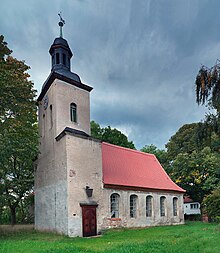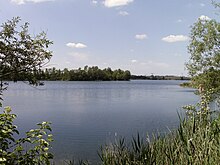Büschdorf (hall)
|
Büschdorf district of Halle (Saale) |
|
|---|---|
| Coordinates | 51 ° 28 '44 " N , 12 ° 1' 56" E |
| height | 92 m above sea level NN |
| Residents | 4576 (Sep 30, 2019) |
| Incorporation | Jul 1, 1950 |
| Post Code | 06116 |
| prefix | 0345 |
| country | Saxony-Anhalt |
| Transport links | |
| Highway |
|
| tram | 4 7 |
| bus | 27 31 43 351 |
Büschdorf is a district in the eastern district of Halle (Saale) in Saxony-Anhalt with 4576 inhabitants. Grown from a settlement on the trade route to Leipzig , Büschdorf extends from the Reide (Reideburg) in the east over the Hufeisensee in the south and the industrial area Halle-Ost to the Diemitzer Graben in the north. The village was a so-called kitchen village, which in addition to Reideburg , Diemitz and Kanena, supplied the Halle region with fruit and vegetables through appropriate agriculture until the end of the 20th century. Büschdorf belonged to the Saalkreis until it was incorporated in 1950 .
Origin of the name
The name "Büschdorf" was probably derived from the name "Biscopes dorf" (Bischofsdorf). He reminds us that in the early Middle Ages the village was the property of the Naumburg bishop Wichmann , who later became the archbishop of Magdeburg . It was first mentioned in a document in 1228. However, the name can also come from the bushes that were still abundant after the clearing. Some farmers therefore had three green bushes in their coat of arms. The name of the place can also be derived from the word “bit” (flood), since the Reide often overflowed its banks and flooded large parts of the fields. Saint Nicholas, after whom the village church takes its name, was the water saint.
history
The first settlement on the ground of today's Büschdorf was built in the 7th century . The whole country was still densely forested. In the marshy valley of the Reide, which flooded large parts of the forest every spring, some families of the Western Slavs, who at that time occupied and exploited the Halleschen brine springs , withdrew . They created a small fortified village that can still be seen in its original form today. The courtyards were built around the village square.
When the Slavs were driven further east by the Frankish emperors, farmers of German origin settled there. But large-scale clearing and drainage did not occur until 1155, when a group of Dutch settlers settled there. A settlement in the swampy and dense forest of no significant economic importance became a farming village. The St. Nikolai Church was also built at that time and the energetic farmers who had worked hard to wrest every meter of arable land from the forest soon produced more grain and, above all, vegetables than they could use themselves. The surplus was sold on the nearby market in Halle. Since 1473, all green goods could be imported into Halle duty-free. The settlement on the trade route in the Electoral Saxon area became the “kitchen village” of the city. Büschdorf belonged to the Giebichenstein office in the hall circle of the Archbishopric of Magdeburg . In 1680 the Duchy of Magdeburg came under Brandenburg-Prussian rule.

During the French occupation (1807 to 1813) Büschdorf belonged to the Napoleonic Kingdom of Westphalia . The place was chief lieu of the rural canton Halle in the district Halle ( department of the Saale ). During the political reorganization after the Congress of Vienna in 1815, Büschdorf was attached to the administrative district of Merseburg in the Prussian province of Saxony in 1816 and assigned to the Saalkreis.
For a millennium, Büschdorf consisted of a maximum of 20 houses. However, when Halle became an industrial city that began to burst at the seams, and more and more companies moved out of the city, Büschdorf grew with it. The population increased from 135 in 1825 to 1019 in 1910. In 1868 the first factory was built in Büschdorfer Land, the roofing felt factory Büsscher & Hoffmann on Äußere Delitzscher Straße. In addition, the cocoa and chocolate factory (today the Halloren chocolate factory ), four iron foundries , the basin construction companies, three sheet metal factories and a bridge building company were built. On May 9, 1914, the tram line C, which was built for 300,000 marks and connected Halle with Büschdorf, was inaugurated.
On July 1, 1950, Büschdorf and Reideburg were incorporated into the city of Halle (Saale).
Infrastructure
Today Büschdorf lives mainly from the settled industry, such as the Halloren chocolate factory and the printing and publishing house of the Mitteldeutsche Zeitung in Delitzscher Strasse, as well as agriculture. Vegetable cultivation is one of the economic pillars of the rural district of the city of Halle.
After 1990, new single-family houses and other residential buildings were built on former vegetable fields. These let the population rise to over 4,000 and changed the appearance of the village, whereby the rural character was largely retained. The new Osttangente and the planned sports complex at Hufeisensee will bring further changes . Further new residential areas are already being planned, for example the settlement on the former school garden.
The shopping center called Büschdorfer Mitte has existed since August 8, 2014. The HEP shopping center is only a few minutes away from the center of Büschdorf and can be easily reached by car or bus.
The Büschdorf district has a primary school and a municipal day-care center.
Streets
The L 165 road runs through Büschdorf from Halle to the A14 exit "Halle (Saale) -Ost".
Local public transport
With the opening of tram line C, which led from the main train station via Delitzscher Strasse and Büschdorf to Schönnewitz , Büschdorf and Reideburg were connected to the Halle tram network on May 9, 1914 . As early as 1915, the route was extended by around 700 meters to just before the Reideburg church.
Since the line change on November 1, 1921, line 9 has been running on the 9.6 km long Seebener Strasse - Reileck - Markt - Riebeckplatz - Büschdorf - Reideburg route. Later the line 10 went to Reideburg, which made possible a direct tram connection of Reideburg to the main station and market of Halle until it was closed on May 21, 1971. With the commissioning of the Wendeschleife in Büschdorf on February 20, 1961, the long-term out of the line to Reideburg had already been indicated.
After the route was extended by 1.3 kilometers to the center of Büschdorf, the Büschdorf residential area has been reconnected to the Halle tram network ( HAVAG ) since summer 2012 . Since then, you can take tram line 7 from the Kröllwitz district to Büschdorf in 37 minutes. This tram line can be used to reach the main train station as well as the city center, the university and the Reileck. During rush hour, you can also take tram line 4, which then runs to Alfred-Schneider-Straße, to reach the University Hospital and the Weinberg Campus .
Bus route 43 connects the Damaschkestrasse district in Halle-Süd with Büschdorf.
literature
- Hans Krech : My hall. Literary-historical cityscapes, Verlag Dr. Köster, Berlin 2006.
- Peter Findeisen and Dirk Höhne: The village churches in Halle (monument sites - monument values vol. 3). State Office for Monument Preservation and Archeology Saxony-Anhalt - State Museum for Prehistory, Halle 2006, pp. 58–69. ISBN 3-939414-00-X .
Web links
Individual evidence
-
↑ Hallescher Quarterly Report 2019/3
- ^ Büschdorf on www.halle-ost.de
- ↑ Mention of the place in the book "Geography for all Stands", p. 124.
- ↑ Royal Decree, which ordered the division of the kingdom into eight departments . List of the departments, districts, cantons and communes of the kingdom. In: Landschaftsverband Westfalen-Lippe (Hrsg.): Project Westphalian history . 1807, p. 187 ( PDF 4.9MB [accessed January 1, 2014]).
- ^ The hall circle in the municipality register 1900
- ^ "Büschdorfer Mitte": New shopping center opens to customers . In: Mitteldeutsche Zeitung . ( mz-web.de [accessed on October 22, 2017]).
- ↑ Walter Müller: 100 years ago a tram went to Reideburg for the first time. (No longer available online.) In: SonntagsNachrichten. February 21, 2015, archived from the original on September 24, 2015 ; accessed on August 15, 2015 .




